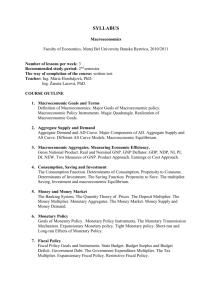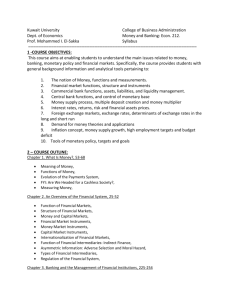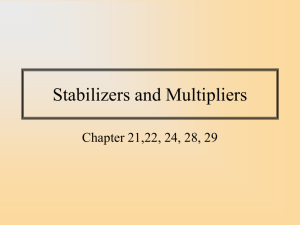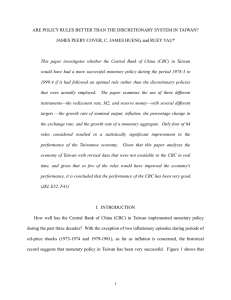Money Supply Control and Financial Innovation
advertisement
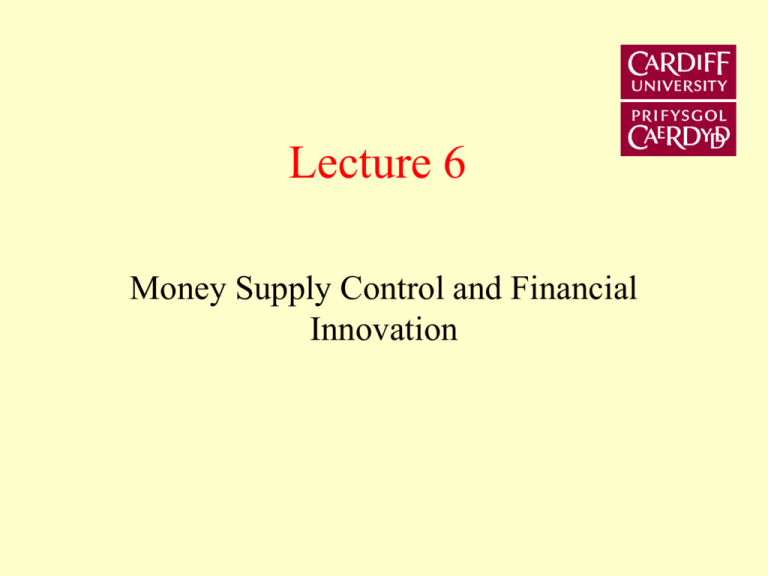
Lecture 6 Money Supply Control and Financial Innovation • Examine the simple money multiplier approach to money supply determination • Examine the meaning of financial innovation. • Examine implications for the monetary system and the transmission mechanism • Implications for monetary control • Examine the counterparts approach to money supply determination The money multiplier • Mechanical link between base money and broad (bank) money • Treats base money as exogenous • By assuming that the ratio of currency to deposits and reserves to deposits is constant, the link between base money and broad money is the multiplier. The mechanical link • • • • • • Let H = base money H=C+R Let M = broad money M=C+D Divide M by H The multiplier m = M/H Algebra of Money Multiplier H CR M CD M CD H CR C 1 M D C H R D D M mH C 1 D m C R D D Principal causes of financial innovation • High variable and unpredictable inflation leading to high variable and unpredictable rates of interest • Restrictive regulations tending to discriminate against certain kinds of Financial Institutions • Development of technology Three strands of financial innovation • Switch from asset to liability management • development of variable rate lending • cash management technology Financial innovation and the demand for money M f ( P, Y , Rb ) d M f ( P, Y , Rb Rd ) d Implications for monetary policy Rb LM post-FI LM pre-FI Y Implication of decreasing interest rate sensitiveness of the demand for money y y 0 R u M d y R M M v E (u ) E (v ) 0 s * E (u ) ; E (v ) 2 2 u 2 2 v Continued v y0 M * y Y 0 M * 2Y ( ) 2 M * let u2 0 2 Y 2 0 v2 2 u2 Y2 2 2 ( ) 0 u Technology • • • • EFT = Electronic Fund Transfer ATM = Automated Teller Machines POS = Point of Sale Machine Technology enables banks to reduce unit costs • better able to maintain profitability in the face of declining spreads Counterparts to broad money • • • • • Government financing identity G-T=H + B Bank balance sheet L + R = D + E Broad Money M = C + D Base Money H = C + R Deriving the counterparts • • • • • From the last 3 equations M = (H-R) + D substituting for D M = (H-R) + (L+R-E) taking differences, solving for H and substituting in the financing constraint • M = (G-T) + L - B - E Demand for bank credit (loans) • Complicated function of a number of variables • the loan rate • spread • expected inflation • expected demand • costs of borrowing from abroad or capital market Monetary Control Techniques • Open Market Operations • Infinite supply of base money at the current rate of interest. • Interest rate policy. • Taylor rule - reaction function. Taylor Rule Rt t yt y * t 1 2 * t 1 2 * t Money Stock Control - Two Monetarist Experiments • USA - 1979-82 Base Control • UK 1980-85 Medium Term Financial Strategy (MTFS) • Two views concerning the pace of monetary control • 1) Gradualist • 2) Sudden death US experiment • In October 1979 the Fed switched from controlling Fed funds rate to controlling non-borrowed reserves to target M1 • Bankers and professional economists argued that the shift to a form of base control would cause greater fluctuations in interest rates Inflation expectations and long-term bond yields • Bond rates did not reflect a fall in inflation expectations • Financial innovation - development of NOW accounts • Required reserves based on lagged accounting basis The US Experiment - a model Rt yt E Pt 1 E Pt t (1) IS M t pt y t Rt t (2) Md yt y * ( M t E M t ) vt (3) Aggregate Supply ht M t Rt ut (4) Money supply t 1 t 1 t 1 To examine the instrument choice problem - let the policy instrument be R, set to satisfy some target M*. Therefore Rt R E Rt t 1 from (2) taking expectations M * E p t E y t E Rt t 1 t 1 t 1 (5) subtract (5) from (2) ( M t M * ) ( p E pt ) ( y t E y t ) t t 1 t 1 (5’) Taking expectations of (3) E yt y * t 1 Then yt E yt ( M t E M t ) vt t 1 t 1 (6) Assume that prices are pre-set in the short period, so that there are no one period * surprises. Thus pt tE1 pt 0 and note tE1 M t M Thus M t M * ( M t M * ) vt t 2v 2 (1 ) 2 2 m (7) Let base money be the policy instrument to hit a target M*. Therefore ht M * E Rt (8) t 1 subtract (8) from (4) 0 ( M t M * ) ( Rt E Rt ) ut t 1 but from (2), taking expectations and subtracting M t M * ( pt E pt ) ( y t E y t ) ( Rt E Rt ) t t 1 t 1 t 1 substitute for Rt tE1 Rt from (9) and for y t tE1 y t from (6) (9) * ( M M ) ut * * t M t M ( M t M ) vt t u ( M t M * ) 1 (v t t t ) 2 2m 2 2 v 2u 1 2 (10) Comparing (10) and (7) it is not clear which is the superior instrument Allow for lagged reserve accounting ht M t 1 Rt ut (11) * Taking expectations of (2) and setting tE1 M t M M * E p t E y t E Rt t 1 t 1 t 1 (12) Take expectations of (11) and note that tE1 ht ht ht M t 1 E Rt t 1 substituting for tE1 Rt in (11) into (12) ht M t 1 E y t M * E pt t 1 t 1 (11’) substituting for ht from (11) and thereby eliminating Mt-1 Rt ut E yt M* E p t 1 t 1 t substituting for R from (2) and re-arranging M t pt ( y t E y t ) M * E pt t 1 since t 1 p t E p t 0 and y t E y t ( M t M * ) v t t 1 t 1 vt t then u t t Mt M * u t (1 ) 2 2v 2m 2 2u (1 ) 2 (13) Volatility • Clearly (13) > (7) • Monetarists argued that excessive volatility led to a risk premium being priced into bond rates. • A temporary rise in monetary growth could have led to a rise in long term rates because people confuse a short term increase with a long term increase. Further Distortions • The fluctuations in short rates gave additional impetus to the development of new financial instruments NOW, Super NOW, Money Market Mutual Funds etc. • Distortion of the money supply figures led to the abandonment of the target in 1982. UK - Experiment • MTFS announced targets for public sector deficit as % of GDP and M3 growth • Autumn 1979 exchange controls abolished ability to re-route intermediation offshore • 1980 - credit controls and controls on deposits abolished • Banking sector liberalised • Broad money failed to signal the 1980-81 recession Conclusion • Experiment with monetary targeting was not an unqualified success • Financial innovation and financial sector deregulation had blurred the boundaries between money and non-money and distorted the established links between broad money and other economic variables • Inflation targeting has an implicit monetary control





